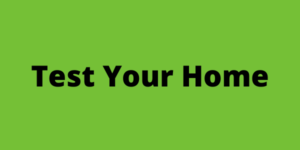Wondering if radon gas might be a problem in your home? View the map below to see if radon is a likely hazard in your area.
 A map depicting the potential radon hazard in Ontario
A map depicting the potential radon hazard in Ontario
*Note - edited map to emphasize Southern Ontario.
If you take a look at the map above, you can see that many locations in Southern Ontario are deemed Zone 1 - High hazard. Below, you can see the radon potential for these areas:
- Kitchener: High Hazard
- Waterloo: High Hazard
- Hamilton & Ancaster: High Hazard
- Burlington: Elevated Hazard
- Guelph: High Hazard
As you may have noticed from this map, areas along the Niagara Escarpment are at higher risk of elevated radon gas. Radon concentrations vary geographically due to the levels of uranium in the ground.
What Is Radon Gas?
Radon is a radioactive gas that naturally occurs in the environment. As uranium, a heavy metal naturally occurring in the earth, decays, the radioactive radon gas is released.
Radon gas is everywhere, and it is constantly being produced, as uranium is present in rocks and the earth’s crust.
Radon gas is similar to carbon monoxide in that it is tasteless, colourless, and odourless. This means that if there is excess radon gas in your home, you would not be able to tell.
As radon is released from decaying heavy metals in the ground, it tends to be a problem in lower levels of the home, such as basements and crawl spaces.
Why Is Radon Gas Considered a Hazard?
Radon gas is naturally occurring and is harmless outdoors. When radon is released outside, it is diluted and is not a concern for our health.
However, when radon gas is confined in your home, it can accumulate to dangerous levels. When high levels of radon gas is in your home, it can pose serious health risks.
Radon gas and tobacco use combined significantly increase the likelihood that an individual will get lung cancer. For example, Health Canada reports that lifelong smokers have a 1 in 10 chance of getting lung cancer.
However, lifelong smokers who are also exposed long-term to radon gas have a 1 in 3 chance of getting lung cancer. For a non-smoker exposed to long-term radon gas, there is a 1 in 20 chance of getting lung cancer.
What Is The Acceptable Level of Radon In My Home?
As mentioned above, it is impossible to completely eliminate radon gas. All homes in Canada have some level of radon. Low levels of radon are not dangerous.
When you get your home tested for radon, you get to see if you have a concentration high enough to require radon mitigation.
Indoor radon gas is measured using Becquerels per cubic metre (Bq/m3). This unit of measurement checks the emission of radiation per second. The Canadian guideline for radon gas in the home is 200 Bq/m3.
If your levels of radon gas are below 200 Bq/m3, you may still choose to pursue mitigation services. While risk from radon at these levels are low, no level of radon exposure is considered 100% risk-free. Therefore, it is up to the homeowner to decide what level of risk they are comfortable with.
How Can I Test My Home For Radon Gas?
Now that you know a bit more about radon, you may be worried that the levels in your home are high. Fortunately, testing for radon is simple and easy.
You can purchase a radon test kit and install it yourself, or you can hire a professional and have them test for you. Radon gas tests are typically done over the course of at least 3 months.

You will want to use the test kit in the lowest area of your home that you use for 4 hours a day or more. For some homeowners, that is the basement (e.g. frequently using a living space in the basement or a home office), and for others that is the main floor.
There’s Radon in My Home - Now What?
If you have completed a test and have discovered that there are high levels of radon gas in your home, there are mitigation strategies to help bring those levels down.
A radon mitigation system can be installed in your basement or area of the home where radon gas is highly concentrated. However, in most cases, radon levels are problematic in the basement, so that is where most testing and mitigation systems will be installed.
If radon levels in your basement are high, the first thing to do is seal off any openings or cracks where radon gas could be coming from. This includes any issues around sump pumps, plumbing openings, hydro entry, floor cracks, etc.
Then, a system (typically consisting primarily of a pipe and fan) is installed in the foundation and works by sucking out radon gas and exhausting it outdoors.
Why Choose Radon Gas Guys
The Radon Gas Guys care about the health and safety of homeowners. We are committed to helping families mitigate radon issues and help everyone in our community stay safer.
When we work with you, we have a 100% guarantee that our radon systems will work. If the radon mitigation system does not reduce the levels below the Canadian standard, we will correct it at no cost or refund your money.
If you are wondering about radon levels in your home, you can quickly and easily buy a test kit from our site. Or, you can give us a call to discuss your options and find out more about radon testing and mitigation.
Rick did an excellent job installing a customized Radon mitigation system, he was diligent, patient, professional, informative and made sure the space is spot clean before he left. He came well prepared, and had all the needed tools, and as a result, the job went very well! I highly recommend him.
